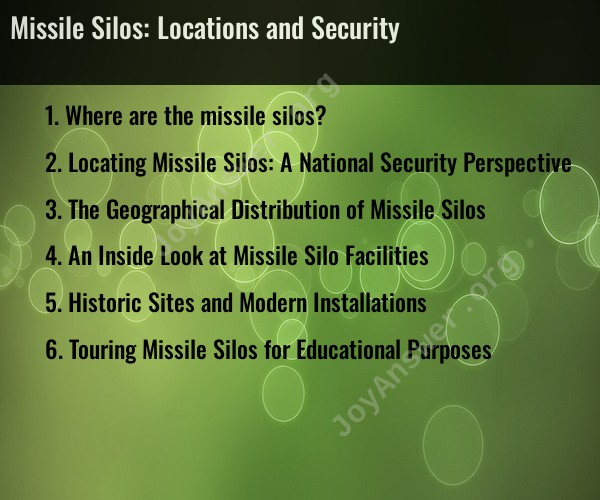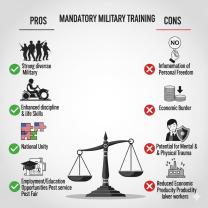Where are the missile silos?
The locations of missile silos are typically not publicly disclosed, as they are considered highly sensitive military installations. Missile silos are used to house intercontinental ballistic missiles (ICBMs) and other strategic missile systems, and their exact locations are closely guarded secrets for national security reasons.
Missile silos are commonly found in countries with nuclear arsenals and are used as part of a nation's nuclear deterrence strategy. In the United States, for example, these silos are scattered across several states, primarily in the central and northern regions. The exact number and locations of missile silos may change over time as governments modernize their missile systems, but the specific information about their locations is typically classified for security reasons.
If you have a specific reason to know about the locations of missile silos or are interested in this topic, I recommend referring to publicly available sources of information, such as government reports, declassified documents, or scholarly research on nuclear arsenals and missile systems. However, be aware that such information is often limited and may not provide precise current details on missile silo locations.
Locating Missile Silos: A National Security Perspective
Missile silos are hardened underground structures that house intercontinental ballistic missiles (ICBMs). ICBMs are long-range missiles that can carry nuclear warheads. Missile silos are designed to protect the ICBMs from a nuclear attack.
The location of missile silos is a matter of national security. The United States and Russia, the two largest nuclear powers in the world, have both agreed to disclose the locations of their missile silos under the New START treaty. However, China, India, Pakistan, and North Korea have not disclosed the locations of their missile silos.
The Geographical Distribution of Missile Silos
The United States has 450 ICBMs deployed in missile silos across the country. The silos are located in 10 states: Colorado, Montana, Nebraska, North Dakota, South Dakota, Wyoming, Missouri, Kansas, Iowa, and Illinois.
Russia has 528 ICBMs deployed in missile silos across the country. The silos are located in 12 regions: Altai, Amur, Ivanovo, Kaluga, Kozelsk, Krasnoyarsk, Orenburg, Penza, Perm, Saratov, Sverdlovsk, and Tagil.
China has an estimated 280 ICBMs deployed in missile silos across the country. The silos are located in several provinces, including Gansu, Hebei, Heilongjiang, Inner Mongolia, and Xinjiang.
India and Pakistan have a small number of ICBMs deployed in missile silos. The silos are located in remote areas of both countries.
North Korea has an estimated 20 ICBMs deployed in missile silos. The silos are located in several provinces, including North Pyongan, South Pyongan, and North Hamgyong.
An Inside Look at Missile Silo Facilities
A missile silo facility is a complex structure that includes the following:
- A hardened underground silo that houses the ICBM
- A launch control center where the ICBM can be launched
- A support complex that provides power, communications, and other essential services to the silo and launch control center
The silo is typically a cylindrical structure that is buried deep underground. The silo is made of reinforced concrete and is designed to withstand a nuclear attack.
The launch control center is typically located near the silo. The launch control center is a hardened underground facility that is designed to protect the personnel and equipment that operate the ICBM.
The support complex is typically located several miles away from the silo and launch control center. The support complex provides power, communications, and other essential services to the silo and launch control center.
Historic Sites and Modern Installations
Some missile silo facilities are now historic sites. The Minuteman Missile National Historic Site in South Dakota preserves a missile silo and launch control center from the Cold War. Visitors to the site can learn about the history of the Minuteman missile program and see a missile silo and launch control center firsthand.
Other missile silo facilities are still in use. The United States Air Force maintains a fleet of 450 ICBMs deployed in missile silos across the country. These missiles are a key part of the United States' nuclear deterrent.
Touring Missile Silos for Educational Purposes
Some missile silo facilities offer tours for educational purposes. The Minuteman Missile National Historic Site offers guided tours of a missile silo and launch control center. Visitors can learn about the history of the Minuteman missile program and see how the missiles were operated.
Other missile silo facilities also offer tours, but they may be more limited in scope. For example, some facilities may only offer tours of the exterior of the silo and support complex.
Touring a missile silo is a unique opportunity to learn about the history of nuclear weapons and the role that missile silos play in national security. However, it is important to note that some missile silo facilities are still in use and may be restricted to visitors.










